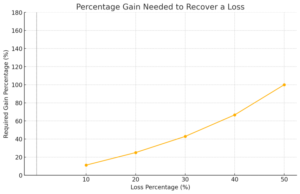Understanding the Importance of Limiting Losses
The concept that in trading, if losses are incurred, a significantly higher return is required to recuperate those losses is a well-established tenet. This is a consequence of the mathematical principles underlying percentage calculations. To illustrate, should one suffer a 50% loss of capital, a 100% gain would be required merely to reinstate the initial position
Let us consider the following situations, assuming an initial capital of 100 units.
- 10% loss
- 20% loss
- 30% loss
- 40% loss
- 50% loss
For each of these losses, we will calculate the percentage gain required to return to the initial capital.
The graph demonstrates that as the percentage loss increases, the percentage gain required to recover the initial capital rises markedly. The following section presents the specific details:
- A loss of 10% requires a gain of 11.1% to recover.
- A loss of 20% requires a gain of 25%.
- A 30% loss requires a 42.9% gain.
- A loss of 40% requires a gain of 66.7%.
- A 50% loss requires a 100% gain.
Strategies for Limiting Losses
It is of the utmost importance for any trader to limit their losses in order to ensure the sustainability and longevity of their career. The primary objective is to safeguard capital, as substantial losses have the potential to deplete a trading account and impede recovery. The implementation of effective risk management strategies, such as the establishment of stop-loss orders and the calibration of optimal position sizing, is of paramount importance. It is similarly important to maintain psychological stability, as substantial losses can lead to emotional and irrational decision-making. From a statistical perspective, the management of losses is an effective means of enhancing the overall expectancy of a trading system, as it ensures that the average returns exceed the average losses. In light of the inherent unpredictability of financial markets, rigorous loss-limiting measures serve to safeguard against unforeseen adverse movements, thereby maintaining a stable equity curve and enabling profitable market participation.
Best regards,
TradingQuant






